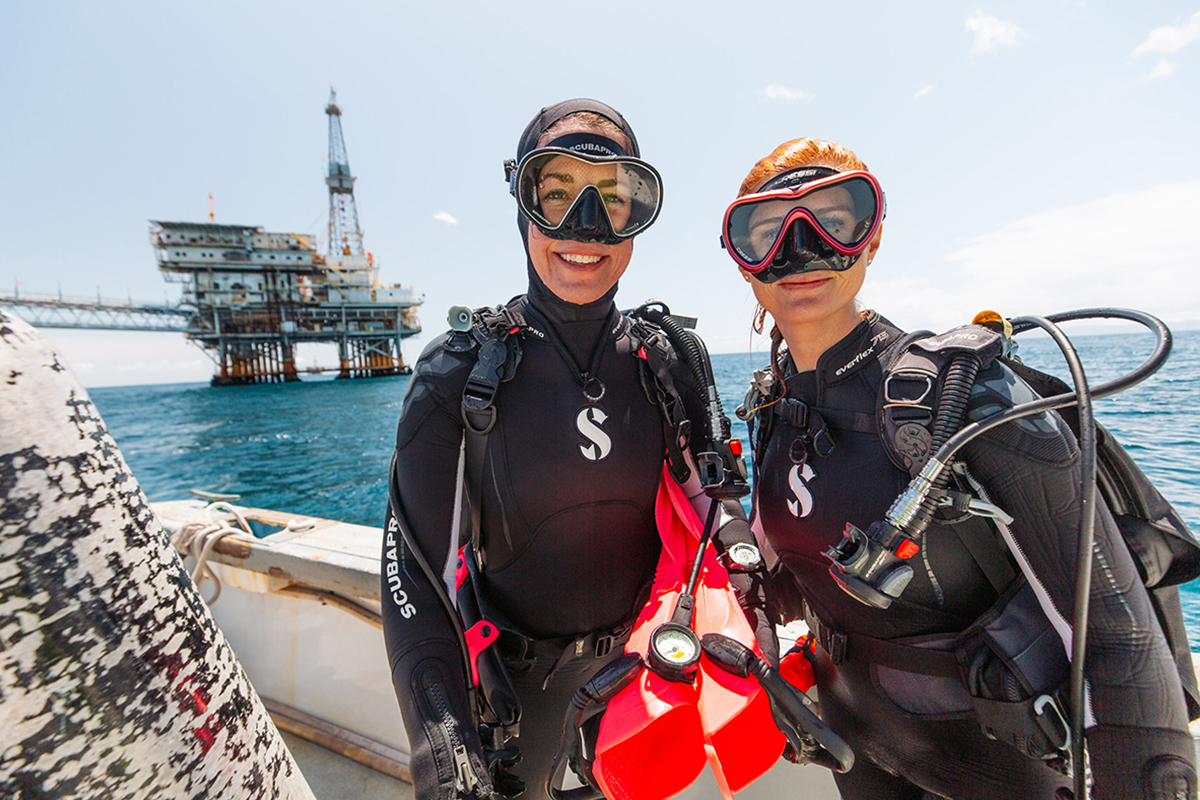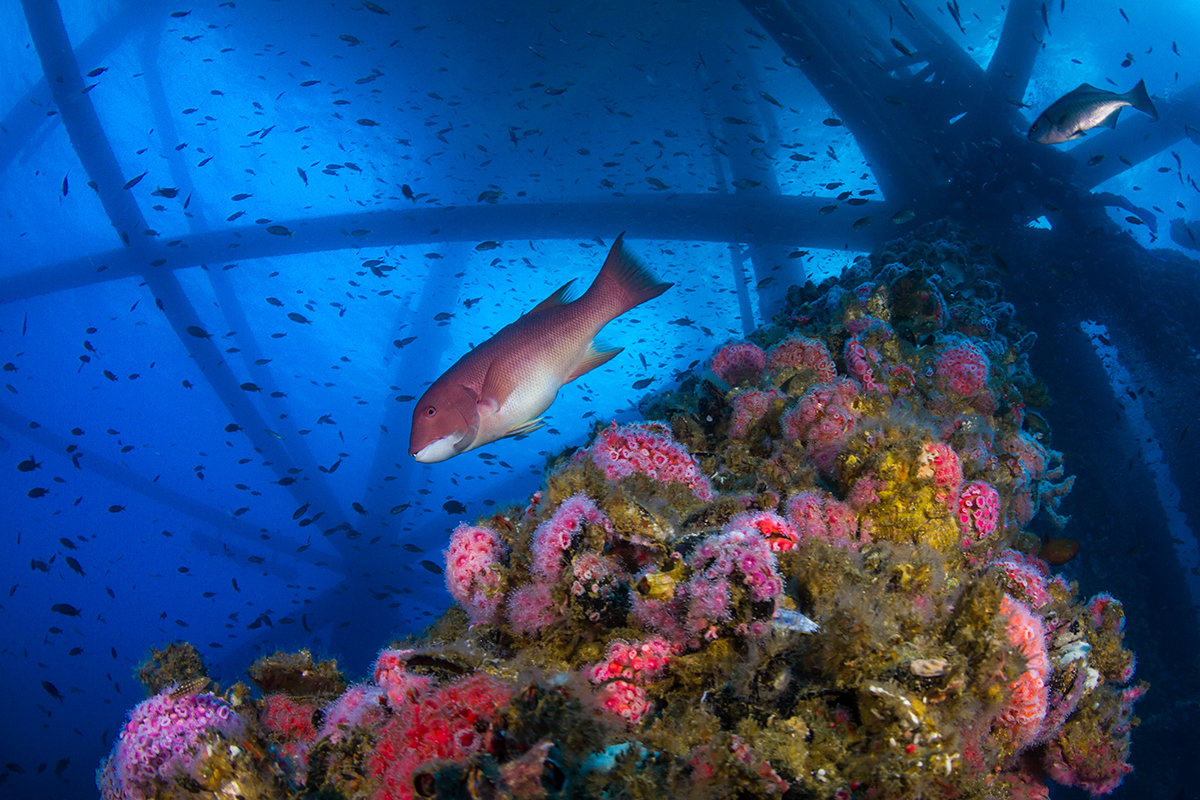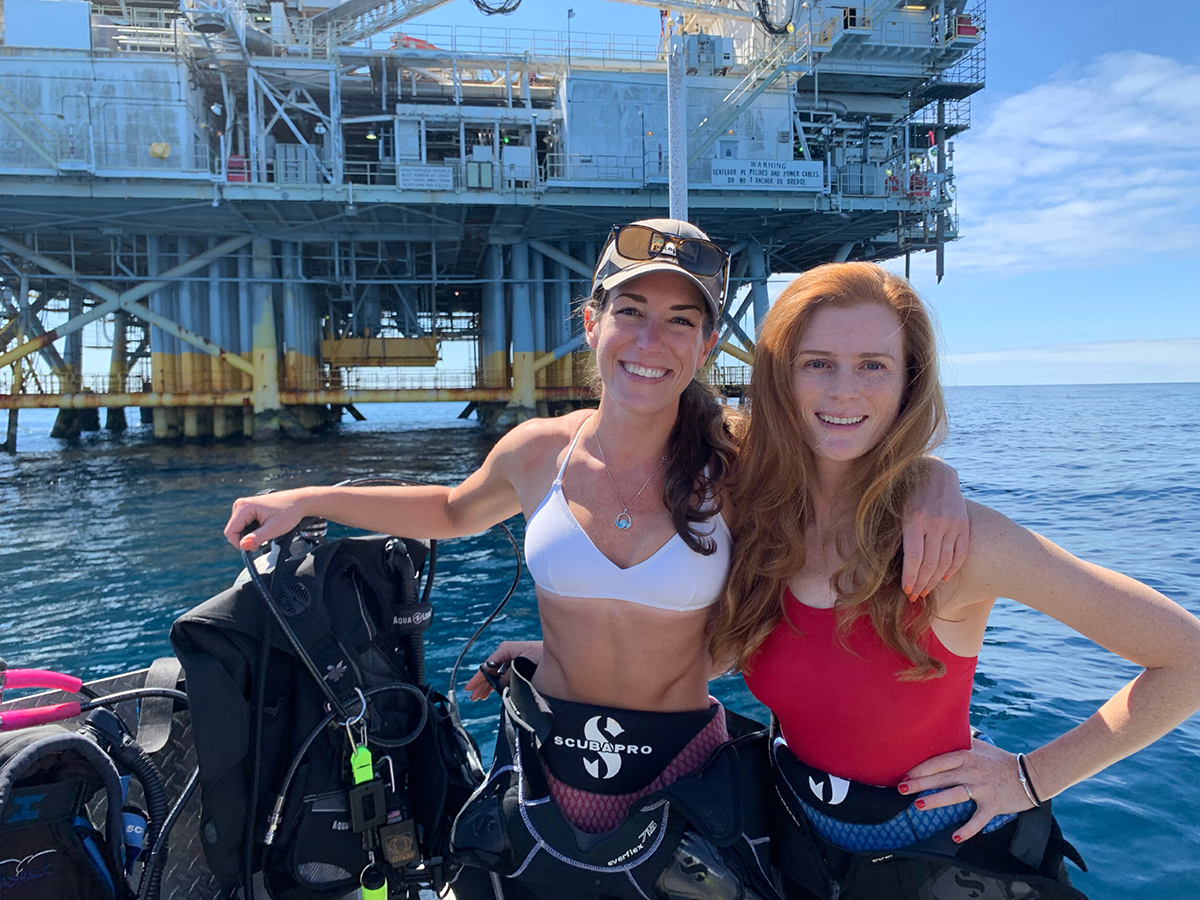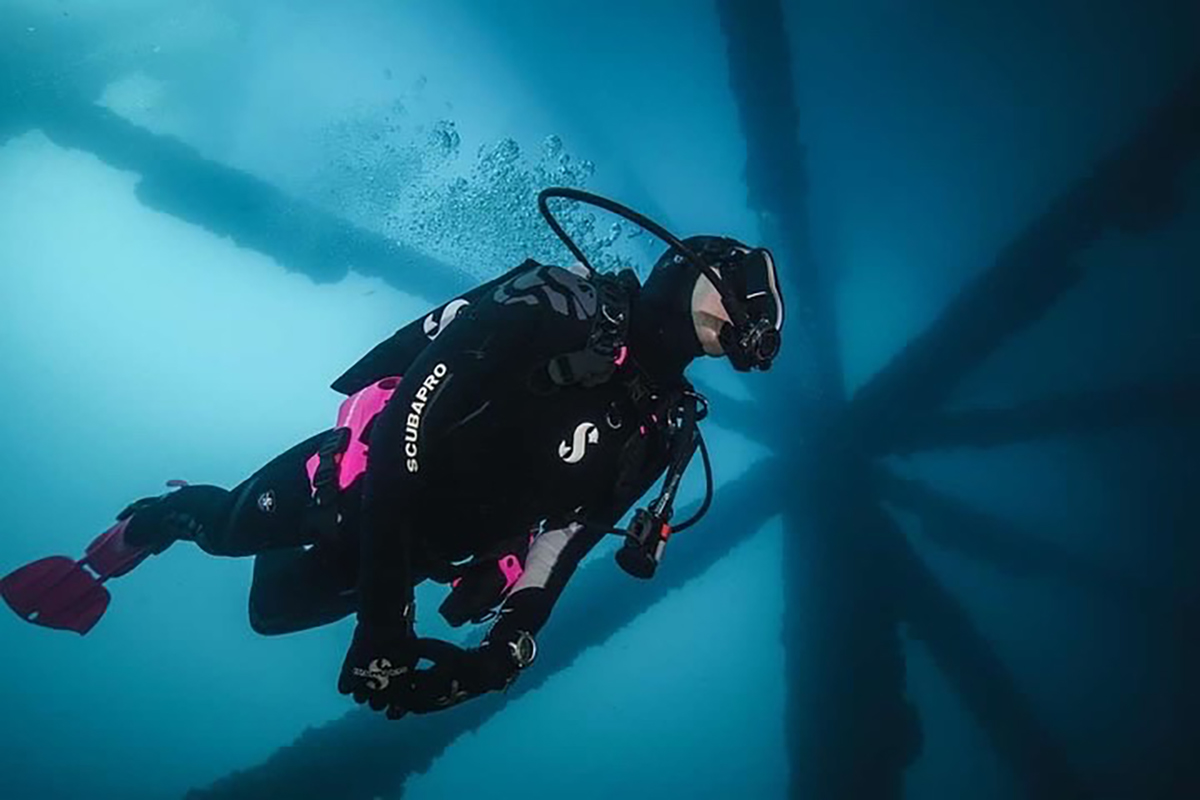
Emily Hazelwood and Amber Jackson before a dive around a nearby decommissioned rig
After meeting at the Scripps Institution of Oceanography, Emily Hazelwood and Amber Jackson founded the Blue Latitudes Foundation in 2018 to explore the untapped potential of decommissioned oil rigs. Here, they speak to LUX about how these infrastructures might be unlikely friends of marine wildlife
LUX: Could you share the story behind the creation of your organisation and what motivated you to focus on ocean conservation?
Emily Hazelwood: After I graduated from college, I got my first job working as an environmental field technician in the Gulf of Mexico following the events of the 2010 British Petroleum oil spill. The spill covered over 1,300 miles of the Gulf Coast in oil and threatened not only the physical, economic and food security of the Gulf’s communities, but also resources for businesses worldwide. I had never witnessed the devastating impacts of humankind on our oceans so acutely, and this experience went on to shape the rest of my career.
However, my time spent in the Gulf of Mexico is also where I first learned about the Rigs to Reefs program, where retired oil platforms are repurposed and given new life as artificial reefs, and where I began to think differently about ocean conservation. The concept fascinated me. How could a structure capable of such intense environmental degradation also be capable of supporting marine life in a positive way?
I completed a master’s degree at the Scripps Institution of Oceanography in California investigating the social, economic, and ecological implications of re-purposing offshore oil and gas platforms into artificial reefs. Scripps was also where I met Amber, and in 2018, we launched the Blue Latitudes Foundation to broaden the dialogue on traditional ocean conservation practices and find ways to use our oceans without using them up.
Amber Jackson: After graduating from UC Berkeley with a bachelor’s degree in marine science, I pursued my graduate studies at Scripps, met Emily, and together we embarked on a thesis project that would ultimately shape our organisation’s vision of repurposing decommissioned oil rigs in California.
Follow LUX on Instagram: luxthemagazine
As we delved deeper into our thesis project, we discovered the tremendous ecological potential of these rigs. Contrary to conventional practices that involve complete removal of the rig and associated infrastructure from the ocean floor, we recognized the value of the platform jacket—the steel scaffolding supporting the drilling infrastructure—as a thriving marine ecosystem.
Traditionally, oil companies are responsible for decommissioning oil rigs once the wells dry up. This process includes capping the well and removing everything from the ocean floor, which incurs significant costs. At Blue Latitudes, however, we conduct comprehensive environmental impact assessments of each oil rig, assessing the existing and future underwater ecosystems. When a rig is deemed suitable for repurposing into an artificial reef, the oil company can choose to either topple the steel structure onto the ocean floor or cut it to a height that allows ships to pass over. In doing this, the company saves millions of dollars and the repurposed rig creates an artificial habitat that fosters marine life.

A decommissioned oil rig and its thriving marine ecosystem
LUX: How do these artificial reefs compare to natural reef ecosystems?
EH: First and foremost, we want to conserve and preserve our natural reefs to the greatest extent possible. However, we recognise that we are quickly losing many of our natural reefs and the installation of artificial reefs is becoming increasingly important.
That being said, we don’t want to just use any material for our artificial reef construction projects; we want to think about materials that are sustainable and can last in the water column for long periods of time, meaning they won’t leach any chemicals or breakdown over the years. We also want to think about materials that would not only attract marine life, but would actually foster the production of marine life. That’s part of what makes offshore oil and gas platforms excellent candidates for artificial reefs. Some offshore oil platforms are as tall as the Empire State Building, which means a lot of real estate for marine life to grow. Additionally, these structures are very complex with lots of beams and cross beams, and this complexity will initially attract marine life and eventually begin to produce marine life. Finally, they were designed to remain in the water for long periods.
LUX: You are also both PADI certified rescue divers and Ambassadivers. Did you gain these qualifications because of your love of being in the ocean?
EH: I come from a family of scuba-divers who, from a young age, supported my passion and curiosity for the sea, encouraging me to get scuba certified by the age of 12. They took me around the world to explore different ocean ecosystems, and every site we visited gave us the opportunity to research the different creatures that lived there and attempt to identify them during our dives.
This passion to explore the world’s oceans has stayed with me to this day, drawing me to places like the tiny island of Utila in search of whale sharks, to oil platforms in the heart of the Gulf of Mexico, to searching for Wobbegons and Leafy Sea Dragons off the coast of Sydney. As I have grown older, that passion has evolved into academic curiosity which led me to pursue my dive master certification.
I would encourage anyone to consider diving; there is no other experience in the world like it. Diving is your first step towards exploration of the unknown, and once you have experienced it, there is no going back.

Blue Latitudes co-founders Emily Hazelwood and Amber Jackson
AJ: Becoming a PADI certified rescue diver was an important step for me. It not only expanded my knowledge and skills in diving but also equipped me with the ability to handle challenging situations underwater. The training involved learning essential rescue techniques, mastering buoyancy control, and enhancing my overall diving competence. It instilled in me a sense of responsibility and preparedness to assist others in need while exploring the marine environment.
Being an Ambassadiver has been an enriching experience as well. I have had the privilege of representing the diving community and promoting marine conservation initiatives. It has allowed me to engage with fellow divers and enthusiasts, sharing knowledge and raising awareness about the critical issues facing our oceans.
LUX: Amber, as a former Ocean Curator at Google, in partnership with the Sylvia Earle Alliance, how do you see the future of the role of big tech companies in conserving our oceans?
AJ: I firmly believe that the future of ocean conservation relies on the active involvement of big tech companies. Technology and innovation play a pivotal role in safeguarding our oceans for generations to come.
I envision big tech companies taking the lead in this endeavour by making substantial investments in monitoring and reporting technologies. These advancements will not only make the state of the world’s oceans easily accessible to all, but also provide a platform for informed decision-making and collective action.
Read more: Wendy Schmidt on philanthropy, technology and unexplored oceans
By leveraging their resources and expertise, these companies can contribute to the development of cutting-edge tools and platforms that enable real-time data collection, analysis, and visualisation. Such technologies have the potential to revolutionise our understanding of marine ecosystems, track environmental changes, and identify areas that require immediate attention and conservation efforts.
LUX: How do you engage with the public to raise widespread awareness about the importance of your work?
EH: We find that with much of our work, seeing is believing. It’s hard to convey to the public the ecological value of an offshore oil and gas platform mostly because when people see an offshore oil platform, they think of destruction and oil spills. They definitely don’t think of a thriving reef ecosystem. To resolve this issue we like to introduce the public to the underwater space using underwater photography, videography, and most recently 360 videography, enabling us to use virtual reality to take audiences diving with us below the surface
LUX: What advice would you give to individuals or organisations interested in pursuing work in the field of marine conservation?
EH: I believe that we have seen success with our research into the Rigs to Reefs program because it’s unique and different and it radically challenges the way we think about ocean conservation. We’re not ‘save the whales’, although that’s still incredibly important, we’re ‘save the oil platforms’ and that tends to grab people’s attention. I would encourage anyone interested in pursuing work in the field of marine conservation to take on challenges that are often overlooked. We know more about the surface of the moon than we do about our oceans, especially the deep ocean. There is still so much left to learn and explore about our oceans.

Scubadiving near a decommissioned rig
LUX: What are your key goals and aspirations for the Blue Latitudes Foundation for the future?
AJ: In the future we’re hoping to expand the Blue Latitudes Foundation research and education efforts into the offshore wind and aquaculture spaces. We have primarily focused on the oil and gas industry, with a specific interest in converting offshore oil platforms into artificial reefs. Increasingly, however, we’ve recognized that there are a lot of lessons that can be applied to the offshore wind industry from the oil and gas industry, such as designing wind farms that not only support marine life but also support offshore aquaculture ventures as well as fisheries.
LUX: What do you hope our oceans will look like in 2033?
EH: Industry and the environment aren’t known for working together successfully, but it doesn’t necessarily have to be that way. As we continue to develop and utilise offshore resources, we must be keenly aware of our footprint on the environment and opportunities to mitigate our negative impacts. My hope is that we will start to see more offshore wind farms dotting our coastlines, and for the continued emergence of sustainable offshore aquaculture farms. I hope that we continue to pursue opportunities that allow us to utilise our oceans sustainably without using them up.
AJ: In 2033, I envision our oceans as thriving, resilient ecosystems that have rebounded from the challenges they currently face. I hope to see significant progress in ocean conservation efforts, driven by global collaboration and heightened awareness of the importance of our marine environments.
I hope that sustainable fishing practices will be the norm, ensuring the long-term health and abundance of fish populations. I hope we will witness the widespread adoption of responsible aquaculture techniques that minimise environmental impacts and prioritise the well-being of marine life. Marine protected areas will have expanded, safeguarding vital habitats and biodiversity hotspots. These protected zones will serve as sanctuaries for marine species, allowing them to flourish and maintain balanced ecosystems.
Through advancements in technology and innovation, we will have a more comprehensive understanding of the ocean’s health. High-resolution monitoring systems, including satellite imaging and underwater sensors, will enable real-time tracking of ocean conditions and provide early warnings of environmental threats. This knowledge will empower decision-makers to take swift and informed action to mitigate pollution and the impact of climate change.
Read more: www.bluelatitudesfoundation.org





